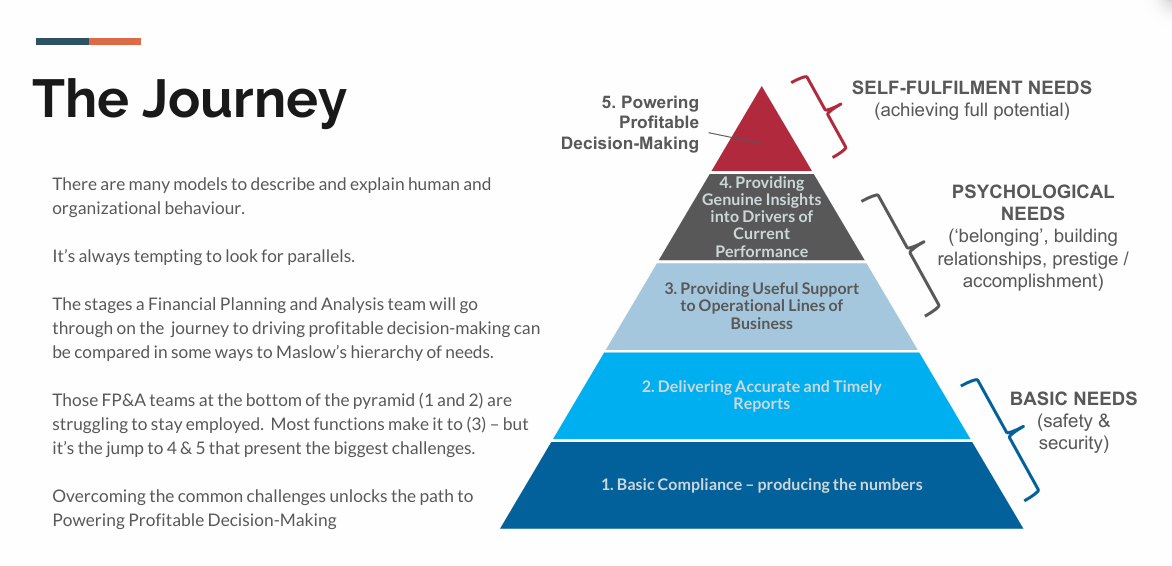Expert Insights: Part 2 – Beyond First Base
 By Declan Rodger | 6 May 2025
By Declan Rodger | 6 May 2025
In the first article in this series we talked to Operations Director, Adam Whittick, about getting started on the path to powering profitable decision-making.
We discussed the path and the importance of getting the foundations in place.
In this article we’ll talk about what comes next.
Part 2: Beyond First Base
Having the foundations of a ‘single version of the truth’, produced every month and without the slog of data gathering and aggregation in Excel is a major step on the journey to powering profitable decision-making. But it’s not the destination.
“Having multiple people working separately on gathering, aggregating and analysing the same bits of data in different ways is not adding value. Releasing them from these low-value tasks is vital. If we go back to our triangle, if we have automated this – created a system that takes millions of rows of data and have it available for analysis at aggregate and detail level in seconds every month – we’re ready to move to the next level.”

Breaking free of the monthly cycle sets us on the path – but how do we move beyond first base? Adam suggests that knowing the direction of travel is more important than spending time trying to figure out the detail of an end goal. Every step is adding value:
“We have clients who have a variety of drivers for moving up the triangle – every one of them is valid. Some are genuinely looking from the top down and trying to fill the gap – others may have more tactical goals. For example, in a manufacturing business with multiple departments all contributing to the financial plan, the logical next step may just be getting the right numbers into the hands of the right people. That can be enormously empowering in its own right.”
Whichever way a business wants to go, it’s vital that everybody is involved in understanding how to get there.
“An easy mistake to make in implementing a system is for the developers to take away the brief, figure out a solution and hand it over to the team as a completed solution. Whilst this might tick the box in the immediate term it doesn’t actually help the organisation along the journey.”
Why is it important that there’s involvement?
“Getting from point A to point B is a valid goal. But because it’s vital that the numbers being used for financial planning and analysis are understood, if getting there involves passing through C then that also needs to be taken into account. That way when analysis throws up something unexpected it is generating insight rather than confusion.”
It would be easy to think of powerful software as a black box that can spit out the answers. Adam is keen to stress that this cannot be the case. Involvement in understanding how the system works is important to all sides.
“I’ve worked on both sides of implementation projects and whilst the steps are always roughly similar it’s the points of difference that are interesting and that create the value. As we put the foundations in place we have to carry out spreadsheet tear-downs to establish how the software will pull the numbers together. I’ve been working with spreadsheets for years in finance functions but every now and again I see somebody do something in a different way to how I would expect it to be done. It’ s finding out why somebody chose to do it that way that often yields insights into what is important in how the data is brought together.”
The engagement in the project has other benefits.
“Nobody likes to have a software engagement ‘done to them’. An ‘imposed’ system creates suspicion and – more importantly – it’s likely to remain static; just used for what it was imposed for until the next change is inflicted on the team.
“I’ve seen a number of implementations in the past where it feels like it was done to the specification of a team that said ‘I’d like the system to do x,y and z’ and the development team have given them what they’ve asked for and nothing more. It has ended up constraining the business because no business is static and new products, new customers, new markets, acquisitions, etc are happening all the time.
“Having the users involved builds an understanding of what is possible as well as why things are done the way that they are. This gives us as developers real insights into the level of flexibility that is going to be required. It also creates buy-in from the users which creates momentum for the journey.”
The system that creates the foundation for the path to profitable decision-making cannot be a black box or a Magic 8-ball that spits out answers when needed. The team using the system needs to understand how it works – being free from the monthly cycle and that understanding drives progress.
“This is one of the drivers behind setting up Spitfire Analytics, we want to empower our customers. We are finance professionals and we’ve all worked in finance functions – we understand the needs and the pressures.
“We want to help our clients drive their business forward. We’re not just about delivering to the specification and ticking boxes. In many cases we help derive the specification because the finance team know what they want to achieve but aren’t software experts – we bridge the gap. In the really satisfying cases, the client has come to understand the system and we’re jointly devising and delivering solutions that power their business.”
Beyond first base is where it starts to get exciting. But to fulfil the potential getting there it’s vital the team on the journey understand how it got there.
Posted 2 months ago in Articles. Filed in Consultancy, Design & Implementation, Finance & Professional Services.





